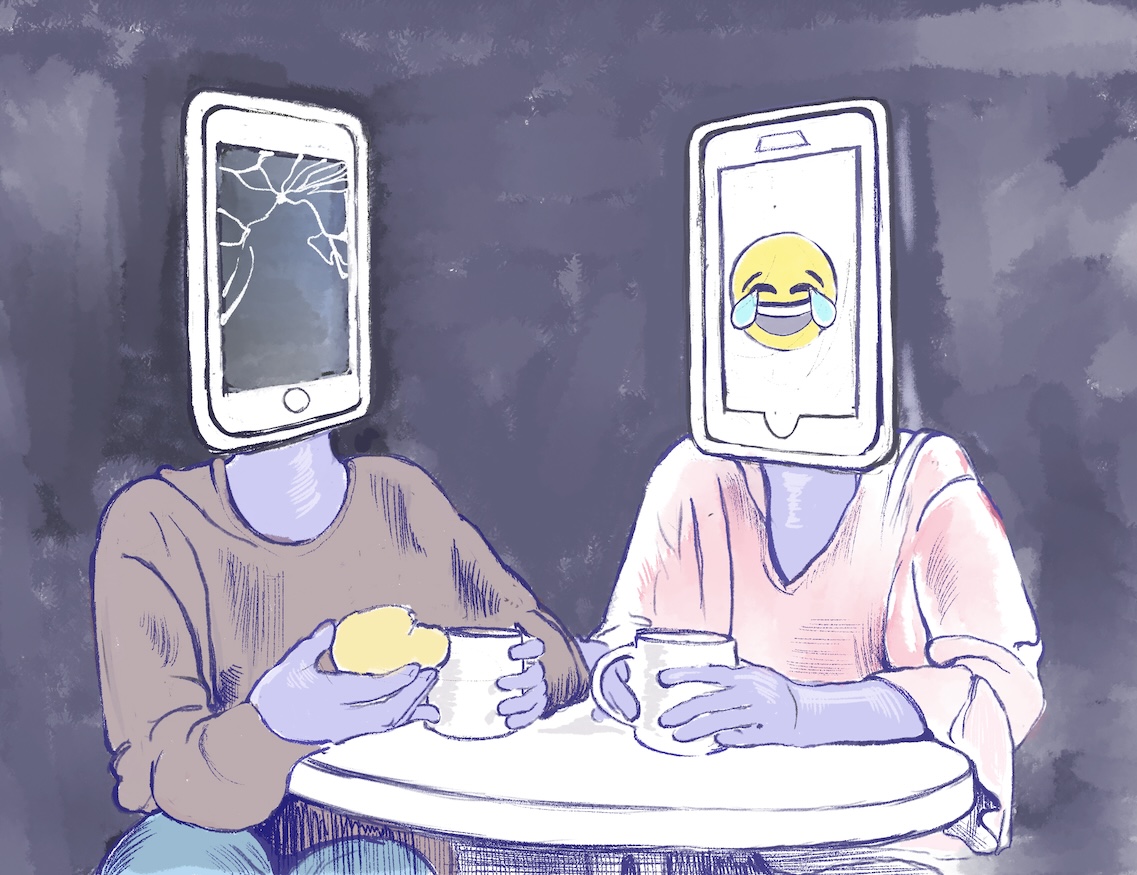
Illustrations by Krista Webster
To Meme or Not to Meme
In eleventh grade, my mental health took a serious turn for the worse. Getting out of bed every day was a struggle, and just going to school was tantamount in my mind to accomplishing a lifelong goal ? probably because I didn’t see my life as something meant to be long. I took to calling this inconvenient ailment “early-onset senioritis”, but evidently, something more serious was at hand. Suicide was on my mind every day and night, and no one seemed to notice. The closest thing I had to a support system was my local Ralph’s parking lot, an empty haven for some of my worst nights alone in my car. Despite my attempts to casually confess how I was feeling to my friends on an almost daily basis, no one took notice. It wasn’t for lack of caring, though. The root of this unrecognized internal turmoil was an acclimation to suicidal tendencies, one of the core values in today’s memes. That’s right: internet memes played a role in my depressive spiral.

|
Figure 1: r/wholesomememes’ top post of all time |
In the past few years, memes have become the staple of internet comedy. They can easily be the glue that holds a community together: the single commonality connecting an otherwise dissimilar group of people. As Ryan M. Milner, a leading scholar on internet memes, points out, “Like inside jokes between friends, internet memes?balance the familiar and the foreign” (Milner, 2016). In fact, certain “subreddits” on the popular website Reddit are completely devoted to the creation and sharing of memes among comically like-minded individuals. Memes can also bring positivity into people’s lives. Some memes have the sole purpose of bringing people up when they’re down ? r/wholesomememes on Reddit, for example, where the most popular posts are based on spreading positivity. The top post of all time, amassing over 134,000 upvotes, is a meme that maintains a positive outlook amidst the typically negative meme narrative. Other meme pages, however, are centered around making light of serious matters, mental health issues included. This is indicative of our society’s tendency to use humor as a coping mechanism, but the widespread nature of the internet and the many platforms within it means that people that do not consider the potential emotional and psychological effects their words may have on an unknown audience. According to Loughborough University, the practice of negative meme-sharing may even be “indicative of a larger apathy” (Casey
et al, 2018), which suggests underlying issues more significant than “just a joke” from both the producer and the consumer. The popularity of memes and the frequency at which they are engaged with offers internet users who crave the approval of others a way to show off their comedic prowess, often through the most popularized memes at the moment. In a recent study, 21% of teenagers reported feeling more popular when using social media (Common Sense Media, 2018), mainly because of the engagement they receive when something they feel comes off as “relatable”. Unfortunately, today’s most “relatable” trend is mental illness.

|
Figure 2: “Kill Me” Meme (Know Your Meme, 2013) |
Mental health issues have de-stigmatized in recent years, in part because of an increasingly progressive culture, and in part because of significantly improved mental health resources (Lorusso and Barnes, 2018). Naturally, as these issues lose their stigma, there is greater openness in the discussion of these maladies and what they really entail. The Internet in particular has evolved in such a way that it now offers platforms on which people can be candid about their struggles (Marie, 2017). This openness, bolstered by anonymity, has enabled the development of a new form of dark humor that often deals with depression and suicidal tendencies. According to clinical therapist Meghan O’Flynn, dark humor “may be a type of cognitive behavioral strategy that serves a dual purpose of exposing individuals to the topics they fear the most along with [the positive physical effects of humor]” (O’Flynn, 2016). Essentially, such humor is a coping mechanism for difficult subject matters or traumas. The origin of internet memes of the suicidal variety appears to stem back to a 2011 meme on Reddit featuring a sullen dog with the bottom text “Kill Me”, reportedly inspired by a scene from the movie
Alien where a creature begs for its life to be taken. (Know Your Meme, 2013). As is the nature of memes, which are defined by their “[circulation] and [transformation] by countless cultural participants across vast networks and collectives” (Milner, 2016), this caption format was taken and applied to numerous other images. After years of cultivation, memes expressing suicidal thoughts like the one seen to the left have since become more common. The basis of this type of humor, sometimes referred to as “edgy” (Know Your Meme, 2018), is to make jokes out of touchy subjects. Some argue that dark humor is a good thing, considering “two things make it easier to speak about difficult subjects: humour and distance ? qualities that memes naturally provide” (Syfret, 2017). This does not mean, however, that there are no pitfalls to go along with the potential upsides of such humor. Dark humor, as seen above, has since become far more widespread than one simple meme and can be found in the form of accounts dedicated to joking about mental health across tremendously popular sites like Instagram, Reddit, and Facebook. Hundreds of pages across these social media platforms have thousands of followers, and are devoted solely to sharing memes about depression, as seen in Figures 3, 4, and 5.

|
Figure 4: A Reddit meme page
|
|
Figure 3: an Instagram meme page |

Figure
5: A Facebook meme page
It is evident that increased openness ultimately led to this vast dissemination of depression-related memes, but this dissemination brings up the question of whether or not that openness is beneficial. In making light of depression, suicide, and other mental health issues online, people remove the gravity of crippling illnesses and normalize unhealthy behavior, making it more difficult to differentiate between serious struggles and “relatable” jokes.

|
Figure 6: Memes depicting mental health struggles |
For some, it can be liberating to see other people online going through the same struggles that they have felt, and to know that they are not alone. However, this increased communal sharing and venting on social media is often not optimal. When users consume memes regarding mental health as seen across almost all social media platforms, they are engaging with this content in an unhealthy and potentially damaging way. With an increased presence of satirical suicidal ideation online comes a decrease in how seriously that same rhetoric will be perceived in real life. In other words, casual conversations about suicide become the status quo. Furthermore, widespread memes that promote unhealthy behaviors normalize said behaviors and put mentally unhealthy internet users at risk of engaging in these practices.
Memes like the ones seen in Figure 6 glorify some of the negative aspects of mental health, and in doing so promote damaging coping mechanisms to young people seeking validation online. These memes paint coping mechanisms related to depression as beneficial or positive, treating the unhealthy behaviors in question with a happy and aloof attitude rather than portraying them as destructive as they can really be. That in turn feeds the cycle of experiencing depression and not seeking help.
In a statement to the UK Parliament, academics from Loughborough University reported that memes “normalize undesirable behaviors” (McGarrigle, 2018). While this specific analysis focuses on the general health of adolescents, the trend is reflective of memes related to mental health as well. One of the Loughborough University researchers, Dr. Ashley Casey, stated, “It is unacceptable for you and I to have a conversation saying I just ate a whole chocolate cake, but if someone puts a meme up about it then I can say ‘that’s normal and that’s okay, that’s how I feel and that’s almost how I behave” (McGarrigle, 2018). This statement holds a direct parallel with how internet users process memes regarding depression and mental health, and the trend of normalization of all types of unhealthy behaviors is rampant across social media. One perilous trend in particular relates to therapy. Consider the following tweets.

|
Figure 7: Examples of anti-therapy tweets (Jay, 2018), (Twitter, 2018) |
These types of tweets, one even from the official, supposedly professional Twitter account, perpetuate the idea that the internet and the complete strangers on it are an acceptable replacement for therapy. Adolescents tend to emulate what they see, and when what they see online is the implication that memes about mental health are a valid equivalent to professional help, they will be less likely to seek out the help they may require.
Internet culture and memes can easily manifest themselves in real life, and when that culture and those memes address such sensitive topics, that manifestation can be dangerous ? fatal, in fact. According to the US Department of Health & Human Services, “Direct and indirect exposure to suicidal behavior has been shown to precede an increase in suicidal behavior in persons at risk for suicide, especially in adolescents and young adults” (US Department of Health & Human Services). This phenomenon, dubbed “Suicide Contagion,” demonstrates that “Vulnerable youth are susceptible to the influence of reports and portrayals of suicide in the mass media” (Gould et al, 2003). Thus, the prevalence of memes that paint suicide in a positive light enable suicidal thoughts in those who are most susceptible, which just so happens to be teenagers. Indeed, Generation Z is the “most likely of all generations to report poor mental health” (American Psychological Association, 2018), and I would contend that the way we talk about mental health online might just be to blame for that.
The internet should not be one’s sole source of emotional support, and the idea that it even could be is wildly ludicrous and incredibly dangerous for suffering teenagers. In consuming memes whose intentions are nothing but to promote ideation of suicide and death, users?especially young ones?put themselves at risk for internalizing this kind of thinking as healthy simply because everyone does it. As Loughborough’s researchers put it, “If young people are?normalising potential damaging behaviour, then it is vital that we better understand the nature, transmission and impact of health knowledge and health messages contained in Internet memes and shared on social media sites among 13-16 year olds” (Casey
et al, 2018). Allowing this trend to continue without further research on its full effects could be deadly for teenagers across America.
Fortunately for me, I realized that the obliviousness in the people around me was simply a product of this depression-oriented digital era, and not a reflection of their love toward me. I started going to therapy to receive the emotional support that my friends and the Internet could not provide for me, and I got the help I needed. But not everyone does. That is why broadening awareness to the seriousness of mental health issues online is vital to bringing about a healthier and happier Gen Z.

Instructor: Dr. D?lice Williams
The fall 2018 section of Honors English 110 focused on Hamilton and the Idea of America A fundamental premise of the course is that America is, among other things, an idea, and a highly contested one. A second premise is that much of the contestation of this idea takes place in and through writing. We spent most of the course focused on the ways that writers, including and especially Lin Manuel Miranda, rendered and defended particular visions of America in essays, articles, monuments, and songs. Despite our focus on this theme, I also wanted to give students as much room as possible to explore a research topic of their interest for the final project. It was important to me that students not feel inordinately constrained in their choices. So my instructions were very general: The only requirement for choosing a research topic was that it needed to be an argument about an issue of national concern. That said, I am very pleased that two of the essays featured in this year’s issue both came from that course and took two very different approaches to the research topic. Emma Rigaud’s essay on perceptions of protest took up our theme head on: she makes the compelling case for the protection of a core American ideal. Maya Walker took another route, arguing that American society needs to pay more attention to the representations of mental health matters on social media. The fact these very strong, compelling, and personal papers came from the same course?a course on Hamiltonindicates to me that it was worthwhile to offer students that most American of American values: freedom.
Works Cited
Works Cited
American Psychological Association (2018). Stress in America: Generation Z. Stress in America? Survey, Accessed 16 Nov 2018
Casey, Ash, et al. MEMEotive – Analysing the Effects of Internet Memes on Young Teenagers’ Health and Health Behaviours. Loughborough University, data.parliament.uk/writtenevidence/committeeevidence.svc/evidencedocument/science-and-technology-committee/impact-of-social-media-and-screenuse-on-young-peoples-health/written/87284.pdf.
Common Sense Media. “Negative Social Media Effects According to Teenagers in The United States as of April 2018, by Emotional Well-being.” Statista – The Statistics Portal, Statista, www.statista.com/statistics/934093/teenagers-emotions-feelings-using-social-media-usa/, Accessed 16 Nov 2018
“Edgy.” Know Your Meme, 8 May 2018, knowyourmeme.com/memes/edgy.
Figure 3, https://www.instagram.com/depressionmemes/
Figure 4, https://www.reddit.com/r/depression_memes/
Figure 5, https://www.facebook.com/DepressionMemesforMindBeans
Gould, Madelyn, et al. “Media Contagion and Suicide Among the Young.” American Behavioral Scientist, vol. 46, no. 9, 2003, pp. 1269-1284.
Image 1 in Figure 6,https://imgur.com/gallery/mhZL0
Image 2 in Figure 6, https://78.media.tumblr.com/f07fec1a8c08ce2366d4c3c08e7fee40/tumblr_ovqkea2dnT1qgqf9to1_1280.jpg
Jay, Santa (VIEWSFROMJAY23). “Seeing a therapist: $100/hour// Telling myself it be like that sometimes: free” 14 October 2018, 11:04 AM. Tweet
“Kill Me.” Know Your Meme, 1 July 2013, knowyourmeme.com/memes/kill-me.
Lorusso, Marissa, and Barnes, Sophia. “Survey: Stress, Stigma and Access Loom Large for Millennials.” Matters of the Mind | A Look at Mental Health and Millennials, 2018, www.themillennialminds.com/survey/.
Marie, Jenny. “Millennials and Mental Health.” NAMI: National Alliance on Mental Illness, NAMI, 1 Dec. 2017, www.nami.org/Blogs/NAMI-Blog/December-2017/Millennials-and-Mental-Health.
McGarrigle, Lia. “Memes Are Damaging Teens’ Health, According to New Study.” Highsnobiety, Highsnobiety, 20 Oct. 2018, www.highsnobiety.com/p/memes-mental-health-study/.
Milner, Ryan M. The World Made Meme: Public Conversations and Participatory Media. The MIT Press, 2016.
Paper Prompt
Writing Project 4: A Researched Argument
80 points
The prompt
- Join an important national or cultural conversation by using your own outside research to support A STRONG ORIGINAL ARGUMENT about an issue of national concern. Use one of the prompts listed on the other side of this page to develop your thesis. Like project 1, this project asks you to synthesize sources. Like project 2, this project has rhetorical components. You should consciously use 2 of the three main rhetorical appeals. (Logos is a given.)
Length and formatting
- 1300-1600 words (not including the works cited page. Lower limit fixed, upper limit flexible)
- double spacing, Page numbers in the bottom center
- Title page with relevant, arresting image and a descriptive, engaging title
Source Requirements
- At least 7 different sources, with the stipulations that
- You need a mix of scholarly and popular sources
- Scholarly: academic articles meant for professors
- Popular: publications/websites meant for the general public
- At least 1 must be a scholarly journal article (we’ll discuss what that is)
- At least 1 must be a visual (graph, chart, illustration, etc.)
- At least 1 source must advance an argument or make a point with which you disagree
- Sources can do “double duty.” That is to say, the source with which you disagree can also be an academic article.
Citation Requirements
- MLA format, internal citations
- Works Cited page (also MLA format) must be included at the end
Models
- Visit ArakJournal.org for some examples of successful research papers from previous 110 courses.
The steps
- Brainstorm & look at examples
- Hunt for facts to give context for the pattern or problem
- Hunt for arguments
- Have a conference with Prof. Williams to discuss your own argument
- Create topic outline (you’ll have a model)
- Create sentence outline (you’ll have another model)
- Compose rough draft (we’ll look at templates)
- Receive feedback from peers & from Prof. Williams
- Revise and edit
- Submit final version via Canvas


